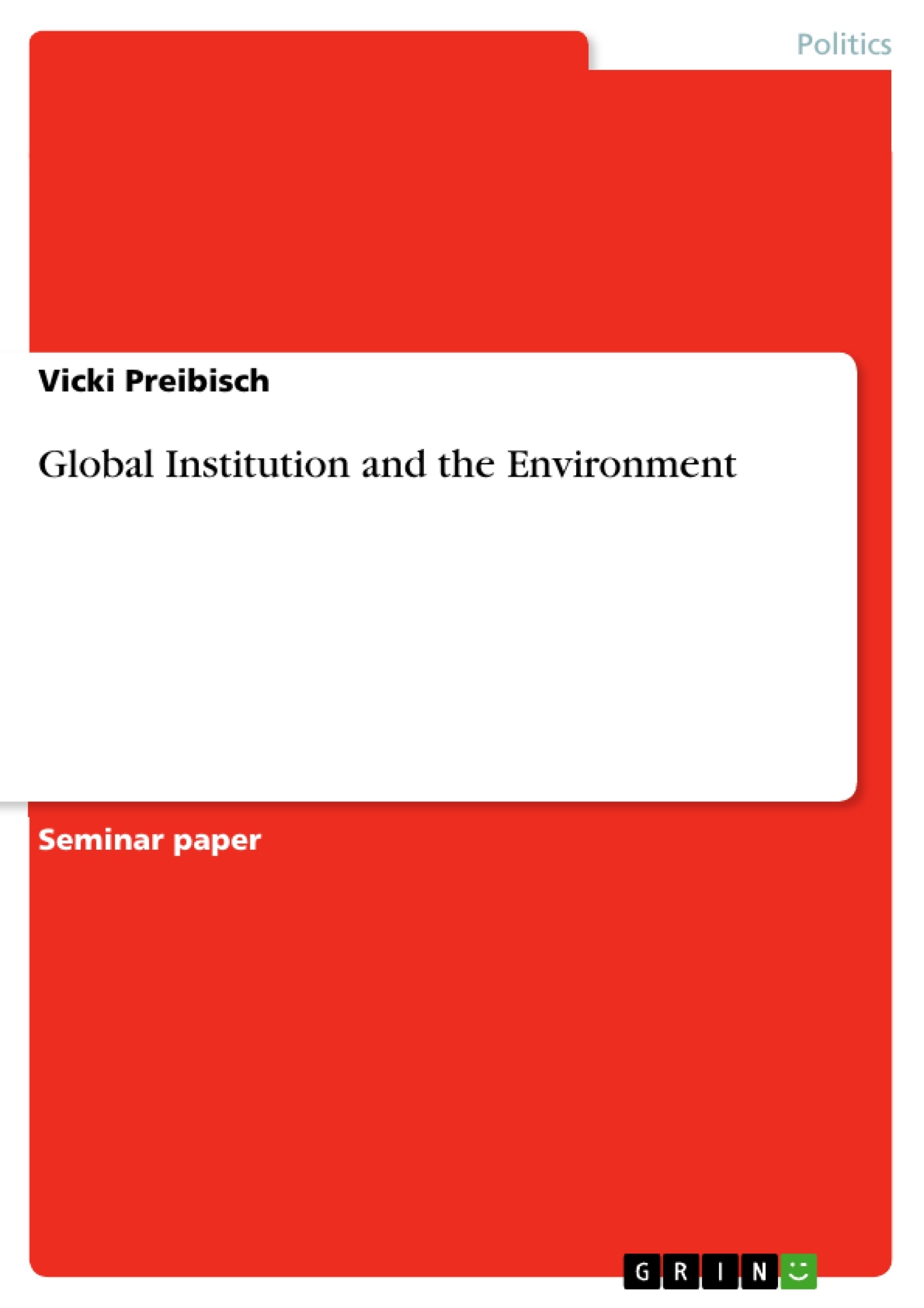Environmental awareness is as great as ever before thanks to environmental actors. One of them are Global Institutions which have been criticised for either not being effective, too bureaucratic or only representing Northern policies. This paper looks into the development of Global Institutions over the last century and examines the World Bank’s responsiveness to environmental concerns. The paper concludes that reaching institutional consensus is difficult besides the rising number of environmental accords.
Inhaltsverzeichnis (Table of Contents)
- Section I: Introducing the Research Paper
- 1.1 Global Institutions
- 1.2 Development of Global Institutions
- 1.2.1 The Pre-1968 Era
- 1.2.2 The Stockholm Era
- 1.2.3 The Post-Rio Era
- Section II: The World Bank's Response to Environmental Issues
- 2.1 Global Governance
- Section III: Conclusion
Zielsetzung und Themenschwerpunkte (Objectives and Key Themes)
This research paper examines the development of global institutions over the last century and analyzes the World Bank's role in addressing environmental concerns. It investigates the effectiveness of these institutions in achieving global environmental benefits and explores the challenges of reaching international consensus on environmental issues.
- The development of global institutions and their evolving role in environmental governance.
- The effectiveness of global institutions in addressing environmental challenges.
- The World Bank's response to and engagement with environmental issues.
- The challenges of achieving international consensus on environmental policy.
- The role of various actors (IGOs, NGOs, etc.) in the global environmental framework.
Zusammenfassung der Kapitel (Chapter Summaries)
Section I: Introducing the Research Paper: This section lays the groundwork for the paper, defining key terms like "global institutions" and "intergovernmental organizations (IGOs)." It introduces the seven main political actors involved in environmental frameworks, focusing specifically on IGOs. The section highlights the debate surrounding the capacity of international institutions to deliver global environmental benefits, setting the stage for the subsequent examination of the World Bank's role. It emphasizes the importance of international institutions in the creation and operation of international environmental regimes and touches on the challenges of implementation in international environmental cooperation. The section establishes the overall scope and objectives of the research.
Section II: The World Bank's Response to Environmental Issues: This section delves into the World Bank's approach to global environmental governance. It likely analyzes the Bank's policies, initiatives, and projects related to environmental sustainability. The analysis likely explores the Bank's effectiveness in addressing environmental challenges, considering factors such as its responsiveness to environmental concerns, its ability to implement effective policies, and its engagement with other stakeholders. The section will assess the Bank’s performance against the backdrop of the overall challenges of international cooperation in the environmental sphere.
Schlüsselwörter (Keywords)
Global institutions, intergovernmental organizations (IGOs), environmental governance, World Bank, international environmental regimes, environmental cooperation, international consensus, sustainable development.
Frequently Asked Questions: Comprehensive Language Preview of Research Paper on Global Institutions and Environmental Governance
What is the topic of this research paper?
This research paper examines the development of global institutions over the last century, focusing on their role in addressing environmental concerns. It specifically analyzes the World Bank's contribution to global environmental governance and the challenges in achieving international consensus on environmental issues.
What are the key themes explored in the paper?
The paper explores several key themes, including the evolution of global institutions and their effectiveness in environmental governance; the World Bank's response to environmental issues; the challenges of reaching international consensus on environmental policy; and the roles of various actors (IGOs, NGOs, etc.) within the global environmental framework.
What sections are included in the research paper?
The paper is divided into three main sections: Section I introduces the research, defining key terms and outlining the scope of the study. Section II delves into the World Bank's approach to environmental issues, analyzing its policies, initiatives, and effectiveness. Section III concludes the research.
What does Section I: Introducing the Research Paper cover?
Section I lays the foundation for the paper. It defines key terms, introduces the main political actors (especially IGOs), and discusses the debate around the capacity of international institutions to achieve global environmental benefits. It sets the stage for the examination of the World Bank's role and highlights the importance of international institutions in creating and operating international environmental regimes.
What does Section II: The World Bank's Response to Environmental Issues cover?
Section II focuses on the World Bank's approach to global environmental governance. It analyzes the Bank's policies, initiatives, and projects related to environmental sustainability, assessing their effectiveness in addressing environmental challenges and considering factors like responsiveness, policy implementation, and stakeholder engagement. The section also places the Bank's performance within the context of broader international cooperation challenges in environmental matters.
What are the key terms and keywords used in the paper?
Key terms and keywords include: Global institutions, intergovernmental organizations (IGOs), environmental governance, World Bank, international environmental regimes, environmental cooperation, international consensus, and sustainable development.
What is the overall objective of the research paper?
The research paper aims to examine the development of global institutions and their role in environmental governance, analyzing the World Bank's role in addressing environmental concerns and exploring the challenges of achieving international consensus on environmental issues. The paper investigates the effectiveness of these institutions in achieving global environmental benefits.
Where can I find a detailed table of contents?
The provided preview includes a detailed table of contents outlining the structure of the research paper, including specific sub-sections within each section.
- Citar trabajo
- Vicki Preibisch (Autor), 2006, Global Institution and the Environment, Múnich, GRIN Verlag, https://www.grin.com/document/67974



